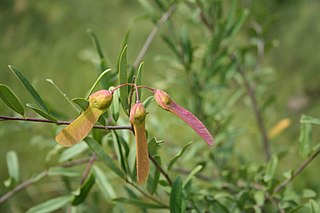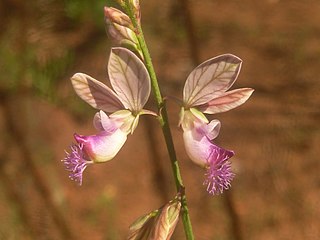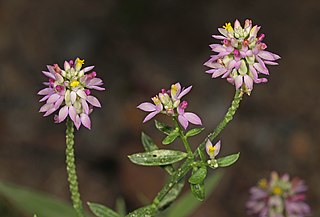
The Fabales are an order of flowering plants included in the rosid group of the eudicots in the Angiosperm Phylogeny Group II classification system. In the APG II circumscription, this order includes the families Fabaceae or legumes, Quillajaceae, Polygalaceae or milkworts, and Surianaceae. Under the Cronquist system and some other plant classification systems, the order Fabales contains only the family Fabaceae. In the classification system of Dahlgren the Fabales were in the superorder Fabiflorae with three families corresponding to the subfamilies of Fabaceae in APG II. The other families treated in the Fabales by the APG II classification were placed in separate orders by Cronquist, the Polygalaceae within its own order, the Polygalales, and the Quillajaceae and Surianaceae within the Rosales.

The Polygalaceae or the milkwort family are made up of flowering plants in the order Fabales. They have a near-cosmopolitan range, with about 21 genera and ca. 900 known species of herbs, shrubs and trees. Over half of the species are in one genus, Polygala, the milkworts.

Polygala is a large genus of flowering plants belonging to the family Polygalaceae. They are commonly known as milkworts or snakeroots. The genus is distributed widely throughout much of the world in temperate zones and the tropics. The genus name Polygala comes from the ancient Greek "much milk", as the plant was thought to increase milk yields in cattle.

Polygala vulgaris, known as the common milkwort, is a herbaceous perennial plant of the genus Polygala in the family Polygalaceae.

Rhinotropis acanthoclada, synonym Polygala acanthoclada, is a species of flowering plant in the milkwort family known by the common names desert polygala and thorn milkwort. It is native to the desert woodlands of the southwestern United States from Utah to the Mojave Desert. It is a small, bushy shrub spreading or growing erect and approaching one meter in maximum height. It is hairy in texture, the youngest twigs hairiest with a feltlike coat of short, whitish fibers. The lance-shaped or oval leaves are up to 2.5 centimeters long. Some of the twigs narrow to spines at the tips, especially in the inflorescences. The flowers are solitary or in clusters of up to 15. Each flower has five sepals, the lateral two white in color and spreading out like wings. The middle petal is keeled, with a flat tip protruding. The fruit is a capsule about half a centimeter long.
Rhinotropis heterorhyncha, synonym Polygala heterorhyncha, is a species of flowering plant in the milkwort family known by the common names beaked spiny polygala and notch-beaked milkwort. It is native to southern Nevada and it is known from a few occurrences just over the border in the Funeral Mountains of California above Death Valley. It is a resident of desert scrub habitat. This desert plant is a perennial herb or small shrub growing in small clumpy mats. The thin, branching, thorny-tipped stems are somewhat waxy in texture and sometimes slightly hairy. They are lined sparsely with small oval, dull-pointed leaves. The inflorescence bears a few flowers, each with a winglike pair of bright pink sepals and a yellow-tipped central petal. The fruit is a vein-streaked capsule.
Rhinotropis intermontana, synonym Polygala intermontana, is a species of flowering plant in the milkwort family known by the common name intermountain milkwort. It is native to the southwestern United States from Utah to northern Arizona and far eastern California, where it grows in desert scrub and woodland habitat. It is a small shrub growing erect or forming tangled, mats of thorny, highly branched stems. The stems are hairy in texture with white fibers. The sparse leaves are linear to oval in shape. The inflorescence bears one to seven flowers, each just a few millimeters in length. The flower has a winglike pair of greenish or whitish sepals and a keeled central petal.
Rhinotropis subspinosa, synonym Polygala subspinosa, is a species of flowering plant in the milkwort family known by the common name spiny milkwort. It is native to the southwestern United States, where it grows in desert and plateau habitat. It is a perennial herb or small shrub growing in a clump no more than 25 centimeters tall. The stems have woody bases and green, thorn-tipped branches. The leaves are up to 3 centimeters in length and generally oval in shape. The flowers have winglike pairs of bright pink sepals and the keeled central petal is tipped with a yellowish beak, sometimes fringed at the tip.

Polygala calcarea, the chalk milkwort, is a species of flowering plant in the family Polygalaceae, native to western Europe. It is a delicate mat-forming evergreen perennial growing to 5 cm (2 in) tall by 20 cm (8 in) broad, with spikes of small, vivid deep blue flowers in spring, and leathery, oval leaves. The white anthers of the flowers may possibly be the source of the name milkwort.

Polygala sanguinea, known as purple milkwort or field milkwort, is an annual plant in the family Polygalaceae. It is native to widespread areas of eastern North America, but is absent from much of the southeastern Coastal Plain. It is it generally found in wet, acidic soils in open areas such as prairies and fields.

Polygala myrtifolia, the myrtle-leaf milkwort, is an evergreen 2-4m tall South African shrub or small tree found along the southern and south-eastern coasts, from near Clanwilliam in the Western Cape to KwaZulu-Natal. It is a fast-growing pioneer plant, a typical fynbos component, and may be found on dunes, rocky places, along forest margins, beside streams, and in open grassland. It belongs to the milkwort family of Polygalaceae.
Hebecarpa rectipilis, synonym Polygala rectipilis, common name New Mexico milkwort, is a plant native to one county in New Mexico and to northeast Mexico. The type specimen was collected near the Town of Hillsboro in Sierra County, at an elevation of 1065 m.

Polygala curtissii, the Curtiss' milkwort or Appalachian milkwort, is a species of flowering plant in the milkwort family. It is native to the Southeastern United States, where it is found primarily in the southern Appalachian Mountains and the Piedmont. Its natural habitat is open, sandy meadows and woodlands.

Polygala lutea, commonly known as orange- or yellow milkwort, is a plant in the milkwort family (Polygalaceae) native to pine-barren depressions and swamps in costal areas of the southern and eastern the United States. It was first described in 1753 by Carl Linnaeus.

Polygala alba, commonly called white milkwort, is a species of flowering plant in the milkwort family (Polygalaceae). It is native to North America, where it is found in Canada, Mexico, and the United States. In the United States, its range is concentrated in the Great Plains and the Southwest. Its natural habitat is in rocky or sandy dry prairies.

Polygala hottentotta is a species of flowering plant in the milkwort family (Polygalaceae). It is native to South Africa, Namibia, Lesotho, Mozambique, Swaziland, and Zimbabwe.

Polygala longicaulis, the longstem milkwort, is a species of flowering plant in the milkwort family (Polygalaceae). It is an annual dicot that is native to the Americas.

Polygala mariana, the Maryland milkwort, is a species of flowering plant in the milkwort family (Polygalaceae). It is endemic to the southern and eastern United States. It is an annual with a height between 4 and 16 inches and it flowers between June and October.
Polygala ramosa is a species of flowering plant in the milkwort family (Polygalaceae). It is endemic to the coastal areas of the Southern and Eastern United States. It is an annual herb with a height of 10 to 40 centimetres that produces yellow flowers between the months of May and September.

Hebecarpa is a genus of flowering plants belonging to the family Polygalaceae. Species are found from the southern United States through Mexico and Central America to western South America.














